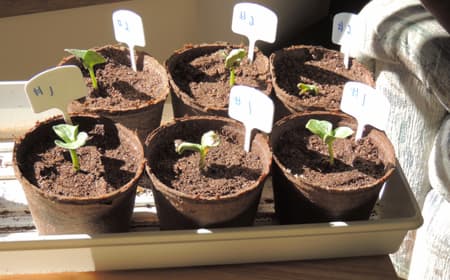Thinning Plants and Seedlings

About Thinnng Plants and Seedlings
Perhaps one of the most difficult tasks in all of the gardening world is thinning plants and seedlings. This chore is essential for healthy plant growth and development, maximizing flower size, and maximizing crop production. Sure, some types of plants tolerate a little crowding. But, that’s the exception, rather than the rule. Every type of plant will show positive benefits when given the proper spacing to maximize its growth.
Haven’t got the heart, or the patience to thin seedlings? Then, space seedlings properly at planting time. The downside to this approach is that germination is rarely 100%. There will likely be gaps in your crops.
Every plant has an ideal spacing. If you saved the seed packet, see the spacing recommendations on the back of the packet. Or, refer to our plant guides.
Tips for Thinning Plants
Thinning plants can disturb those that you choose to keep. Accordingly, you need to work carefully. Here are our recommendations on how to thin seedlings, with minimal disturbance to those plants that will remain:
First, water plants thoroughly before thinning plants. Include a light solution of liquid fertilizer in the water. In addition to providing the plants with a drink, it will soften the soil, making the task of removing plants along with roots easier.
Second, identify the proper spacing for the plants.
Next, select the largest and healthiest-looking seedlings to keep.
Growers often keep the fastest growing plant, even if it is smaller than others.
Grasp the seedling to be removed as close to the ground as possible. Slowly and gently, pull the plant out of the soil. Try to avoid disturbing the remaining plants.
For thinning small seedlings, use small scissors and snip the seedling off at ground level. This works very well with seedlings like carrots and lettuces.
After thinning your plants, give the remaining ones another drink of water. This helps re-distribute soil around the roots.
Add more soil, if roots are exposed.
Thinning Seedlings for Indoor Plants and Transplants
As an avid gardener, you probably love starting seeds indoors for transplanting later. It’s important to thin seedlings in the seed trays and individual pots.
The steps are identical to those described above. Leaving one plant in each pot will maximize growth and development for your transplants. It also allows you to properly space them outdoors at the proper transplanting time.
Thinning Seedlings in a Container
Nowhere is it more important to give young plants growing room, than in container gardens. Indoor plants are in containers for just a brief period. Outdoor plants have the whole garden to grow in, and the roots can go down as far as they’d like in search of food and moisture.
Container plants live their entire lives, in a much more limited and captive environment. The plants draw upon limited moisture and nutrients in the soil of the containers. Their roots may try to spread wider and deeper but are limited by the container wall. Successful container gardening begins with proper plant spacing.
Even with proper spacing, the plants in your container garden need more water and nutrients than the soil holds. More frequent watering and fertilizing are a must.
Related Articles
Please support our site. Shop for:
- rmmatthews100@hotmail.com
- 585-721-6528
- Rochester, NY
©1999-2024 GardenersNet.Com, All Rights Reserved

